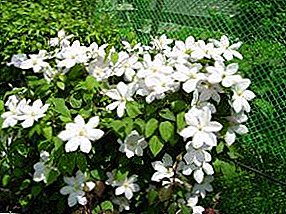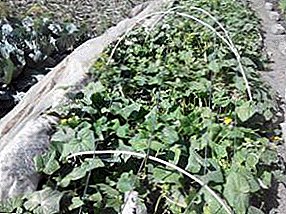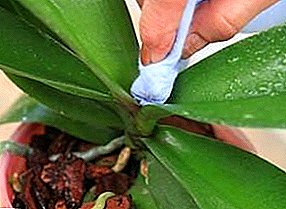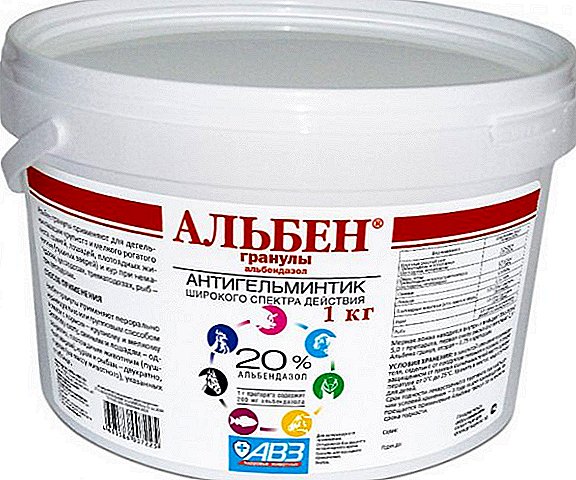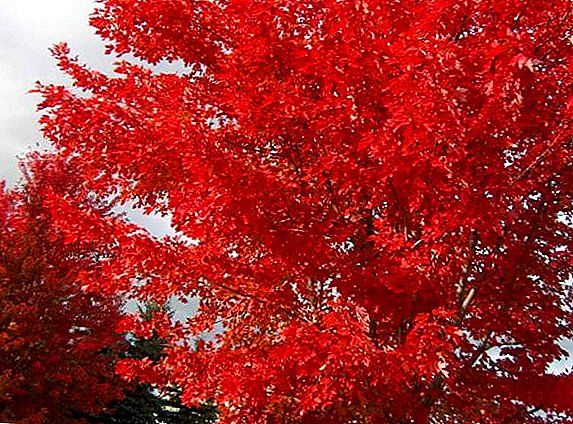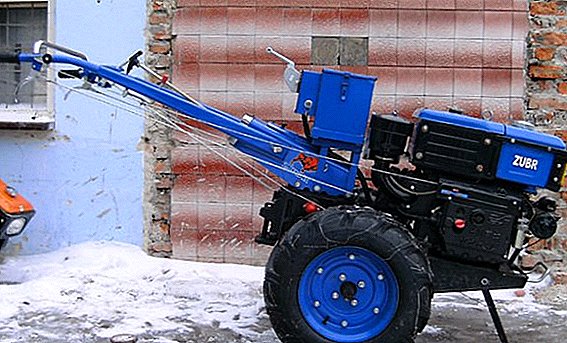 Thuja belongs to the cypress family.
Thuja belongs to the cypress family.
This evergreen tree (or shrub), with a dense crown, will decorate any home farm, suburban area, city courtyard, etc.
In addition to the magnificent green crown, thuja will delight you with its aroma, since its wood contains aromatic essential oils.
In this article we will understand in more detail what the thuja tree is and how to properly care for it.
Types and varieties of Tui
In the world there are 5 types of tui: western, chinese, korean, japanese and folded.
Did you know? The life of a Tui is 90–200 years.
Types of Tui:
- Thuja japanese - tree up to 18 meters with soft needles. Homeland - Japan. It tolerates low temperatures in winter. Does not require a lot of moisture, but does not tolerate polluted air, which is why does not grow in urban environments.
- Thuja korean - a tree that has a wide crown of folding branches. Soft needles are unusual long leaves (up to 2 cm) of elongated triangular-ovoid shape. The needles on the back side are bright silver, and on the front side it is dark green. Homeland - the Korean Peninsula. In Russia grows only in the South.
- Thuja giant or folded - it is a pyramid-shaped shrub that looks like cypress. The fastest growing species of Tui (up to 30 cm per year). It can reach a height of 15 meters, a width of 3 - 5 meters. The needles are dark green, there are white spots below. Crohn shine with a strong aroma. View frost-resistant, wind-resistant. Strong heat tolerates bad, because grows well in wet regions.
- Arbor vitae - it is a shrub up to 18 meters in height, on which there are often bumps of 1-3 cm in length. Branches are vertical, flat. This species tolerates drought, heat, and is not whimsical to the composition of the soil. Winter with low temperatures will not survive.
- Thuja western - pyramidal tree with a height of about 15 - 20 meters and a width of 3 - 5 meters. It has small flowers of greenish-yellow color and red-brown cones. In the summer, the needles have a dark green (lighter below) color, and in winter they take on a brown tint (it turns green again in spring). The root system is fibrous and branched. Western thuja grows well in partial shade, a little worse in the scorching sun (but it does not tolerate severe drought and heat). If this species is planted in a dense shade, then the branches of the thuja are thinning, and this spoils its appearance. Thuja western grows on any soil, is wind-resistant, but in our latitudes, it is most common because of good frost resistance (it has more than 30 varieties).

Did you know? In Russia, thuja appeared in XViii century.
How to propagate thuja
Thuja - unpretentious plant. It grows in the shade and in the sun. It survives well on different soils: peaty, sandy, sandy, marshy, but moisture in the soil should be sufficient.
A plant that has just been planted should receive 10 liters of water per week, and 15–20 liters of water during drought (preferably watered 2 times a week). You need to know when to plant thuja in the country, and at what age the seedling is ready for a new planting site.
Important! It is necessary to plant thuya with a large lump of earth (from a container or from a previous growth site). It is advisable to pour a pit with coniferous earth (1/5 of the needles on the total volume of the earth).
Reproduction thuya cuttings
The gardener should know how to grow thuja in the country. Thuja can breed by seeds or cuttings.
 When breeding, thuja use lignified cuttings (take 2-3-year-old shoots 25-40 cm long) or semi-woody cuttings 10-20 cm long (cuttings should be cut in early spring or in June).
When breeding, thuja use lignified cuttings (take 2-3-year-old shoots 25-40 cm long) or semi-woody cuttings 10-20 cm long (cuttings should be cut in early spring or in June).
Slice the stalk is treated with a solution of heteroauxin. The cutting itself, free from scales from below (about 5 cm) and planted in the soil: river sand, peat and turf ground (1: 1: 1).
Prepared soil disinfect weak potassium permanganate solution. The planting depth is 1.5 - 2 cm, and the seedlings are covered on top (they make a greenhouse).
Important! It is necessary to cut the cuttings so that on the basis of the escape old wood remains - "heel". This contributes to their better rooting.
Cuttings in the greenhouse need periodically to air (airing time increases each time) and moisten the soil (it is better to spray the soil). Rooted cuttings (process lasts 2-3 months) hardened.
In November their warmed leaves, fir branches or sawdust. When the temperature drops to -5 ° C, you need to cover seedling wrap.
Growing thuja from seeds
You can propagate different types of thujas with freshly harvested seeds. Sapling you get in 3-5 years.
 With this method, the seeds need leave in the fall under the snow (this is a natural stratification).
With this method, the seeds need leave in the fall under the snow (this is a natural stratification).
In the spring, seeds from small cones reach and sown in trays at 0.5 cm in depthcover with coniferous sawdust. Seeding trays are set to dark cool place.
Shoots cover shields from the scorching sun. The soil should be constantly loose and wet. Periodically, can be carried out feeding with a weak solution of slurry (1:20).
Recommendations for planting thuja in open ground
Thuja: planting and care in the open field - this is very important information for each gardener. Plant thuy should be in the place where the whole day will not be direct sunlight.
Important! Under the scorching sun the thuja will wither and in the winter from frost will get sick.
 It is also important to know what kind of land is needed for Tui. The best option is turf soil in which added river sand and peat.
It is also important to know what kind of land is needed for Tui. The best option is turf soil in which added river sand and peat.
If you plan to plant several trees of thuja, then keep a distance between them: 1 m (if you plant a single-row hedge), 2 m (if the hedge is 2-row), 5m (if you plan to create an alley of tui). The seedling is immersed in the ground at 60-80 cm.
Many are interested in how to properly transplant thuja so that it does not die. You can repot thuja from spring (from March) to autumn (until November). She tolerates transplant well, of course, only with the right actions of the gardener.
Important! If the soil at the site is heavy and damp, then it will be necessary to make a drainage layer of 15-20 cm. If the site is swampy, then the drainage pipes are laid in trenches.
Outdoor Thuja Care
In the open ground, thuja requires special attention, which consists in regular watering, feeding, loosening the trunk circle and pruning (crown formation).
Watering
 Thuja has lush needles, due to which a lot of moisture evaporates. Therefore, the gardener must ensure that the soil does not dry out (even in autumn).
Thuja has lush needles, due to which a lot of moisture evaporates. Therefore, the gardener must ensure that the soil does not dry out (even in autumn).
A newly transplanted seedling is watered once a week, in the morning or in the evening (10-50 liters of water per 1 tree - depending on the size of the transplanted plant).
Krona, in the first month, is also desirable to irrigate. Sprinkling helps to remove dust from the needles and improve the access of oxygen to the structure of the tree.
Important! The soil near the thuja should be slightly wet. Drying the ground is detrimental to wood. The lack of moisture is determined by the yellowing top of the thuja.
When rainy weather watering should be excluded.
Top dressing
Types of dressings:
- Primary dressing is needed for a tree that has just been planted: Epin, a natural growth stimulator. Top dressing will help the plant to take root and better cope with various diseases.
- Spring feeding consists of potash-phosphorus additives. You can use complex fertilizers "Kemira-universal" (50-60 grams per square meter). Fertilization combined with abundant watering. Top dressing is made twice, with a break of 2 weeks.
- Feeding of a thuja in the autumn is not made.

Important! If during planting mineral fertilizer was applied, then fertilizing should be done only after 2 years.
Pruning
To trim a thuja you will need a sickle and a manual or electric pruner.
Young tree does not touch 2 years (it should take root in a new place), then you can mow it and give shape to the crown. By pruning understand:
- Deletion dried and weak branches (they are usually dry and have a brown color).
- Crown thinning. But do not forget that excessive thinning will reduce the decorative qualities of the thuja.
- Home pruning. The procedure is done in April. In summer, the form is only corrected. The more often you do pruning, the thicker the crown will be. When pruning it is necessary to ensure that the branches are cut no more than 1/3 of the length.

Important! For a "vigorous" type of thuja, it is necessary to remove the branches of a one-year growth.
If you plan to grow the tree in width, then you should cut off the upper part of the crown. Beginning gardeners can start with the formation of a crown of thuja in the form of a ball, curb or cascade.
 If you are interested in an artistic haircut, then ask how to cut thuy smaragd: you can give the tree various forms of animals, spirals, steps, etc.
If you are interested in an artistic haircut, then ask how to cut thuy smaragd: you can give the tree various forms of animals, spirals, steps, etc.
Before beginning a haircut, think carefully about the shape. During work, periodically move aside and see where you need to trim more, and where it is already quite cropped.
Variety smaragd grows year round, because the haircut will need more than one.
Important! Haircut and trimming is done in dry weather.
Preparing thuja for winter
If thuja grows on your site, then it would not be superfluous to ask what kind of care she needs in winter. You need to properly prepare the tree for the winter. For this you may need:
- gardening scissors;
- root formation stimulants;
- peat and any mulching materials (straw, needles, sawdust);
- burlap or special covers for covering coniferous trees.
- To stop the active growth of branches, you must stop feeding nitrogen fertilizers (mid-August).
- Sick, yellowed, broken branches are cut with garden shears.
- The plant should be watered under the root solution of the root, until the onset of cold weather. This procedure contributes to the development of strong deep roots for the winter.
- Pristvolny circle should be mulched (this will protect the upper roots from severe frosts). A layer of mulch 5-7 cm. In the spring it can be removed so that the earth warms up faster.
- In dry autumn, thuja requires moderate watering. Especially the smaragd variety, which grows year-round (and even in winter), needs moisture.
- To protect the trunk from strong winds, you can install a strong count and tie a tree to it.
- To protect the young trunk of the thuja from frost, you can lay bales of straw or hay on the tree.
- To protect against sunburn (they are formed at the end of winter or in early spring, when the sun heats the needles and moisture from the root system still does not come), in the first winter after planting, thuja is wrapped in a rare sacking cloth. But do not wind the trunk too tightly, because during the thaw the freezing of the trunk may occur.

Important!There is a special drug "Purshate", which protects sunflower burns. It should be sprayed on the needles - and a protective film is formed, which will not allow moisture to evaporate. This protective coating is washed with water during rains and tree irrigation.
 In addition, it is possible to build a special frame-shelter around the plant.
In addition, it is possible to build a special frame-shelter around the plant.
Such a venture is quite costly, but is the most reliable answer to the question "How to care for thuja in the winter on the street?".


